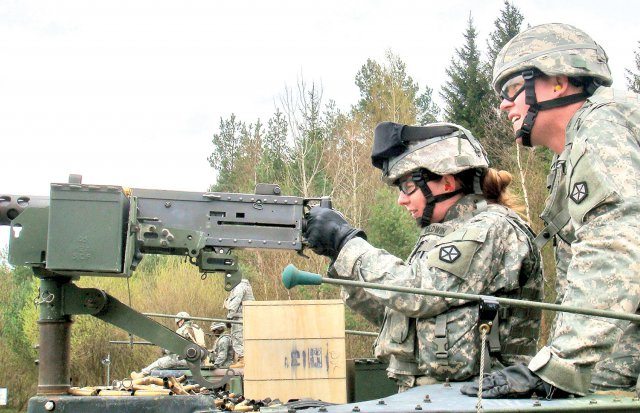The Army announced its intent today to open six occupational specialties and more than 13,000 positions to women.
These six military occupational specialties, or MOSs, were previously closed to women because they were normally co-located with direct combat units:
- 13M Multiple Launch Rocket System crewmember
- 13P MLRS Operations/Fire Direction Specialist
- 13R Field Artillery Firefinder Radar Operator Specialist
- 91A M1 Abrams Tank System Maintainer
- 91M Bradley Fighting Vehicle System Maintainer
- 91P Artillery Mechanic
DOD officials said at a Pentagon press conference Thursday afternoon that they have notified Congress of their intent to open these MOSs to women, and the change will become effective after 30 days of continuous Congressional session, as required by law. This is expected to occur later in the spring, said Maj. Gen. Gary Patton, principal director for DOD Military Personnel Policy.
In addition, officials announced that another 1,186 positions at battalion level would be opened to women in the Army, Marine Corps and Navy. These are in specialties already filled by women, but only at the brigade or higher level.
The 1994 DOD policy known as the Direct Ground Combat Definition and Assignment Rule had prohibited women from serving in combat units below the brigade level. But the secretary of Defense has now granted an exception to policy to allow women to serve in some positions in combat units at the battalion level.
The six specialties previously barred to women were due to the “co-location” element of the 1994 policy. That provision has restricted women from serving in MOSs that by doctrine are located with combat units.
DOD intends to eliminate the “co-location” provision due to the non-linear and fluid nature of today’s battlefield where there often is no front line, said Deputy Under Secretary of Defense for Military Personnel Policy Virginia “Vee” Penrod.
“The battle space we have experienced in Afghanistan and Iraq require our forces to be distributed across the country,” Penrod said. “There is no rear area that exists in this battle space. Continuing to restrict positions as solely on being co-located with direct combat units has become irrelevant.”
Patton said it may take some time to recruit and train women in the six specialties where they haven’t served before. Training them as tank mechanics, for instance, will take longer than placing them at battalion level in MOSs they already know, he said.
Women will be placed in the new positions as men are scheduled to rotate out, Patton said. A normal rotation schedule will be followed and men will not leave the positions earlier than expected, he said.
About 280,000 positions across the services remain closed to women due to the combat exclusion policy.
After six months, DOD will assess the feedback from women serving in the new positions and use the information to take another look at the suitability and relevance of the direct ground combat unit assignment prohibition, Penrod said.
“This is the beginning of the end” of the combat exclusion policy, she added.
“We recognize the expanded role of women in the military,” Patton said. “I’ve seen women in combat perform in an expanded role. I’m very proud of them.”










